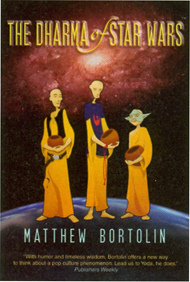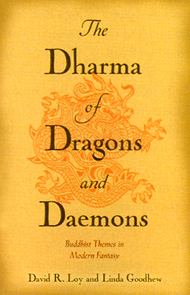The Dharma of Star Wars
Matthew Bortolin
Boston: Wisdom Publications, 2005
205 pp.; $14.95 (paper)
The Dharma of Dragons and Daemons:
Buddhist Themes in Modern Fantasy
David R. Loy and Linda Goodhew
Boston: Wisdom Publications, 2004
128 pp.; $14.95 (paper)
It’s been awfully hard to avoid Star Wars this year. The series of films that began in 1977 finally ended with the release in May of the final installment, Revenge of the Sith. But if you don’t know this by now, you must be living in a faraway galaxy yourself, or attending a very, very secluded retreat.
 A lot has happened in the nearly thirty years since Star Warsfirst appeared. The films have undoubtedly changed Hollywood, helping to usher in the twin eras of box-office blockbusters and limitless spin-off merchandizing. But along the way, in an odd irony of commercialism breeding spirituality, the characters in these films seem to have led some unsuspecting souls toward the Buddha’s path.
A lot has happened in the nearly thirty years since Star Warsfirst appeared. The films have undoubtedly changed Hollywood, helping to usher in the twin eras of box-office blockbusters and limitless spin-off merchandizing. But along the way, in an odd irony of commercialism breeding spirituality, the characters in these films seem to have led some unsuspecting souls toward the Buddha’s path.
Matthew Bortolin appears to be one such fan. In his new, well-timed book, The Dharma of Star Wars, he uses his beloved films as a vehicle for explaining the dharma to other potential followers. This entertaining and insightful Buddhist primer thus provides a useful service to future film buffs who want to better understand the real-life religion behind this popular fictional world.
Anyone who knows the movies only from their commercial detritus will be surprised at how deeply Buddhism—and in particular Zen—permeates the Star Wars universe. There’s no question that creator George Lucas borrowed a great deal from the dharma; he’s been quoted as saying that half his neighbors in Marin County are Buddhists (apparently he hasn’t met the other half ). The Jedi Knights, a sort of enlightened galactic peacekeeping force, wear robes not unlike those of Japanese monks (although the hoods are more reminiscent of Catholic orders), and their weapon of choice is a high-tech saber, which they wield much like medieval samurai. And their philosophy, while a bit muddled in the films, seems to rest on thoroughly Zen-like aphorisms: Keep your concentration on the here and now. You must unlearn what you have learned. Your eyes can deceive you. Be mindful.
Bortolin succeeds in ferreting out some real wisdom from these images and lines, providing a Buddhist interpretation of the Jedi Way. He quotes Master Yoda, the Jedi’s spiritual leader, who explains that “Fear leads to anger, anger leads to hate, hate leads to suffering,” surely words worth remembering for any Buddhist. He even weaves a set of “Zen Contemplations for the Would-Be Jedi,” skillfully blending elements of Star Wars into thoroughly Buddhist practices, exploring themes like attachment, compassion, and mindfulness.
The Dharma of Star Wars makes an interesting counterpart to another recent Wisdom Publications title,
 The Dharma of Dragons and Daemons by David R. Loy and Linda Goodhew. That book also looks at fantasy literature and film from a Buddhist perspective (analyzing the works of J. R. R. Tolkien and Ursula K. Le Guin, among others), though it is strangely dismissive of the Star Wars films themselves. But Loy and Goodhew take a far more academic and analytic approach, exploring topics as complex as Dogen’s philosophy of being-time. Loy and Goodhew construct an interpretation of love as a path to liberation, for example—in which “the other’s well-being becomes more important to us than our own well-being: more important than our fear of death, because more important than our death”—that strikes a deeper chord than Bortolin’s more superficial discussion of “unconditional love.” Where Loy and Goodhew will appeal to those with a strong knowledge of Buddhism who are eager “to find or create Dharma stories that resonate deeply with our contemporary Western spiritual inclinations,” Bortolin is reaching out to newcomers to the dharma who just want to know what Yoda means when he says, “Meditate on this, I will.”
The Dharma of Dragons and Daemons by David R. Loy and Linda Goodhew. That book also looks at fantasy literature and film from a Buddhist perspective (analyzing the works of J. R. R. Tolkien and Ursula K. Le Guin, among others), though it is strangely dismissive of the Star Wars films themselves. But Loy and Goodhew take a far more academic and analytic approach, exploring topics as complex as Dogen’s philosophy of being-time. Loy and Goodhew construct an interpretation of love as a path to liberation, for example—in which “the other’s well-being becomes more important to us than our own well-being: more important than our fear of death, because more important than our death”—that strikes a deeper chord than Bortolin’s more superficial discussion of “unconditional love.” Where Loy and Goodhew will appeal to those with a strong knowledge of Buddhism who are eager “to find or create Dharma stories that resonate deeply with our contemporary Western spiritual inclinations,” Bortolin is reaching out to newcomers to the dharma who just want to know what Yoda means when he says, “Meditate on this, I will.”
In an afterword to the main text, Bortolin addresses the tricky question of the Jedi and violence. The Jedi are knights, after all, and while everyone knows of China’s kung fu monks and Japan’s Zen samurai, most Buddhists today are at least nominally committed to nonviolence. (Bortolin himself is an ordained member of Thich Nhat Hanh’s Buddhist community, which is among the more stringently pacifist sanghas.) Although this is an important and thought-provoking section of the book, it also highlights some of the limits of using the films to explicate Buddhism. Bortolin develops an interesting theory of “compassionate violence,” but he feels understandably compelled to add the caveat that this is not the traditional Buddhist view. In the end, readers may wonder if it is even Bortolin’s own view, or if he is simply trying to provide these fictional characters with a plausible Buddhist defense.
There is some silliness in the book, though that’s probably unavoidable when you’re recording the sacred teachings of an enlightened muppet. The Star Wars in-jokes can be a little much at times, such as when Bortolin offers the koan “If a tree fell on the Wookie homeworld of Kashyyyk and no one was there to hear it, would it make a sound?” or explains that “an unpleasant feeling could be listening to Jar Jar Binks talk.” It’s not obvious what the trivia references add to the discussion in these places, except perhaps to bring a smile to the more die-hard fans.
For better or worse, Yoda has become the archetypal Zen master in the popular imagination, embodying both the positive traits of wise Buddhist teachers and some more unfortunate stereotypes. He is, after all, short, foreign, and has a decidedly unenlightened grasp of English syntax. But for the most part, this little green creature has been a surprisingly effective ambassador for the dharma. In helping Yoda lead a few more moviegoers to Buddhist practice, Bortolin has served his original master very well.
Thank you for subscribing to Tricycle! As a nonprofit, we depend on readers like you to keep Buddhist teachings and practices widely available.